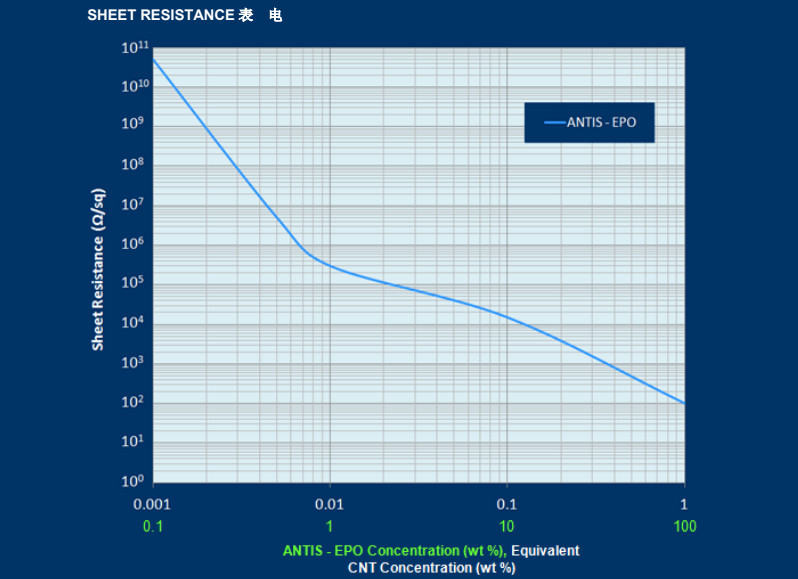Product description
Product description
The multi-walled structure of carbon nanotube-epoxy series is designed specifically for epoxy base products to achieve static dissipation and conductive use of epoxy additives.
ProductsProduct form: viscous paste
Volume resistivity: 2 ohm-cm
Epoxy carrier: epoxy resin (modified bisphenol A liquid epoxy resin)
Carbon nanotube concentration: 1% of weight)
Curing method: can consult the tree ester supplier to confirm the curing agent and curing conditions
Specific gravity: 1.14
Color: Black
Carrier solvent/thinner: None
If the required surface resistivity ≥ 106 Ω is added to the formulation, the carbon content will be extremely low, so the ANTIS-EPO series of epoxy additive products are usually equated to the D.E.R. series of 324 for stoichiometric calculations.

Volume resistivity measurements are made on < 100 micron (< 4 mils) thick films using ANTIS-EPO, EPON 828/D.E.R. 331, EPIKURE 3370 curing agents (no pigments are used) and the resistance is measured after the sample is prepared according to the formulation. Volume resistivity may vary depending on the formulation, curing agent, film thickness and measurement conditions.
The wt% (weight percent) of ANTIS-EPO in the above chart refers to the amount of ANTIS-EPO epoxy additive in the final product (compound). It is calculated as follows.
Example:
1 wt% ANTIS-EPO additive i.e. - final product (compound) using 1g of ANTIS-EPO additive and 99g of epoxy resin and curing agent. The ratio of epoxy resin and curing agent used must be operated according to the supplier's requirements.
Product ApplicationsESD/anti-static protection
Surface Coating and Painting
Ground Leveling
Fiber Reinforced Composite Lightning Protection
Electromagnetic compatibility and electromagnetic shielding
Conductive inks
Adhesive products
Anti-corrosion protection
User's Guide
Dilution of ANTIS-EPO raw batches requires the use of clean, suitable containers that are 3-4 times the size of the mixture section container. For best results, use an electronic scale of suitable accuracy to ensure accurate measurement.
Use a mechanical mixer to mix until uniformity is achieved, during which time the mixing blades and container surfaces need to be checked for material buildup, and if buildup occurs, it needs to be addressed promptly to achieve uniform mixing of the ingredients. In order to obtain the best mixing results, we recommend using high shear mixing blades with a mixing speed of about 1500 rpm.
If necessary, for products with less than 5% additives, the proportion of additives can be gradually reduced by adding the raw material in several steps to achieve the best mixing effect. For example, first mix 5% of ANTIS additive with a certain percentage of the main material, and then pour the remaining main material into the mix when the mixing is complete. After mixing, it is recommended to defoam (up to 10 minutes at 100-200 RPM) and finally empty the container or add other materials such as colorants.
Shelf life (final product (compound) after mixing): This should be confirmed based on actual test results, taking into account the differences in the main ingredients and the mixing ratio. However, in order to ensure the best use of the product, timely use is recommended.
Measurement impedanceThe current is usually very low when measuring the resistance of thin layers of electrostatically dissipative coatings (>106 Ω). It is important to use highly sensitive measurement equipment, such as a megohmmeter with a 5-lb resistance probe that meets the requirements of ASTM F150 or a DC four-point probe analyzer with silver-plated electrodes that meets the requirements of ANSI/ASTM D257. In both cases, the electrode has a much lower resistance than the sample, so care should be taken to prevent sample contamination (in the case of silver-plated electrodes).
Prev
Prev








